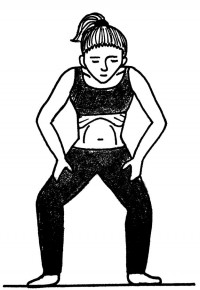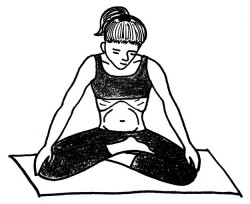The pivotal part of the joy of being a yogi is that with increasing refinement, one decreases the mundane concerns that stand in the way of divine aspirations. Devotion and simple adjustments can help a yogi to also integrate bandhas in his regular practise of yoga. Shiva Samhita, Gheranda Samhita and Hatha Yoga Pradipika, the ancient yogic texts have emphasised the practice of bandhas [energy locks] and mudras [energy seals] along with pranayama and asana for keeping good health.
Bandha is a Sanskrit word meaning ‘to lock’ or ‘to bind together.’ They are advanced practices. Hence, these mechanisms must be learnt from a knowledgeable and experienced yoga teacher.
Before we begin, a word of caution: Beginners must not practise these techniques.
Yoga Bandhas
Bandhas are nothing but muscular locks that direct the flow of prana [vital energy] in specific areas of the body and prevent its dissipation. They are practised along with mudras [finger postures] to arouse the sleeping Kundalini Shakti [cosmic reserves] that lie coiled in a dormant state in the pelvic floor at the base of the spine. Bandhas direct Kundalini Shakti through Sushumna Nadi or the spinal cord into Sahasrara Chakra located in the crown of the head. When this is achieved the practitioner experiences a state of Samadhi—a super conscious experience when the Jeevatma unites with Paramatma [Supreme Being] and one experiences infinite bliss.
On energetic level, bandhas unite prana [upward flow of energy] and apana [downward flow of energy]. On a physical level, bandhas massage internal organs, improve circulation, increase vitality, alleviate stress and slow down ageing. They develop stability and lightness in the torso, prevent outward flow of energy, irrigate the nadis [energy channels] and promote physical, mental and spiritual strength.
Bandhas are practised during kumbhaka or retention of breath. Kumbhaka is conscious holding of the breath without causing strain to the respiratory and nervous systems. It is done after inhalation and also after exhalation. Kumbhaka allows the mind to penetrate deep within and relaxes all the vital organs.
Caution
The practice of bandhas should be avoided by anyone with cardiac problems, high or low blood pressure, fever, asthma, headache, hernia, ulcers, during menstruation and pregnancy. It should not be practiced until a minimum of six months after any surgery.
There are three types of bandhas., namely Jalandhara bandha [chin lock] involving the neck muscles, Uddiyana bandha [abdominal lock] involving abdominal muscles and Mula bandha [anal lock] involving the muscles around the perineum or the buttocks.
To venture into the practise of bandhas make sure you fulfil the following prerequisites:
- Mastery of puraka or inhalation and rechaka or exhalation. The prolongation of these processes must be consistent, smooth and with a rhythm.
- Mastery of kumbhaka or retention of breath. One must be able to exhale steadily or inhale deeply after kumbhaka.
- Mastery of antara and bahya kumbhaka. Antara kumbhaka is retention of breath after inhalation and bahya kumbhaka is retention of breath after exhalation. It is necessary to master retention of breath on inhalation before learning and practicing retention of breath on exhalation.
MULA BANDHA
The Sanskrit word mula means root or source. Mula bandha is contracting the anal sphincter muscles in the pelvic floor and lifting them vertically towards the navel. This bandha prevents apana to flow downwards and outside the body. To practice mula bandha, sit in a cross legged position with your back straight. Inhale deeply and hold your breath [antara kumbhaka]. Contract and draw your anal muscles inwards and upwards as if you are stopping the urine stream. Stay for 5 – 10 seconds. Exhale steadily and release the bandha. This bandha can be also done after bahya kumbaka. Mula bandha can be engaged in tadasana, urdhva dhanurasana, ustrasana, paschimottanasana. The yogis have described mula bandha as an attempt to reach the true source or mula of creation.
Caution
Many people find this bandha difficult because of the tight pelvic floor muscles. It requires inward focus and patience to locate the muscles and to hold it for few seconds.
Benefits of Mula Bandha
Mula bandha locks and distributes energy in the pelvis. The digestive, excretory and reproductive systems are strengthened with this. Also, relieves constipation, piles, prostate, menstrual and menopausal problems.
UDDIYANA BANDHA

The Sanskrit word uddiyana means to rise up or to fly upward. Uddiyana bandha can be practiced in a standing as well as sitting position. It is easier to learn this bandha in the standing position. To practice uddiyana bandha, stand with your legs one foot apart. Bend your knees, lean little forward and place your palms on your thighs with your elbows slightly bent. Lower your head bringing your chin down as in jalandhara bandha. Inhale deeply and exhale quickly with a force to empty your lungs. Hold your breath and draw the abdominal muscles inwards and upwards towards your spine. Maintain this abdominal grip and keep your face and chest relaxed. Maintain this position for 5 – 15 seconds or as long as you can. Release the bandha, soften your abdomen, inhale slowly and come back to the upright position. Repeat it few times. Those with low back pain can practice uddiyana bandha in the sitting position.
Caution
Perform this bandha on an empty stomach, during bahya kumbhaka, or retention after exhalation. Avoid this bandha if you are unable to practise bahya kumbhaka.
Benefits of Uddiyana bandha

Uddiyana bandha binds energy in the abdomen as well as the entire the spinal column. This bandha stretches the diaphragm improves its flexibility, enhances lung functions and also promotes youthful exuberance. It eliminates accumulated toxins, reduces excess abdominal fat, stimulates digestive organs, and relieves back pain. Patients of diabetes and dyspepsia can be particular beneficiaries. The ancient yogis have described this bandha as ‘a lion that kills the elephant named death.’

To achieve transcendental awakening, a devoted yogi must engage in the practise of bandhas and mudras. However, it may take several years to perfect maha bandha which is the practise of three bandhas together. By mastering maha bandha, the practitioner can be at the crossroads of destiny and left to choose between bhoga [enjoyment of worldly pleasures] or yoga [uniting self with the divine]. The unskilful use of the maha bandha can also have a negative impact. Hence, to have it work for you instead of against you, it is crucial to learn and practise it from an experienced teacher. Divine equanimity and detachment can be experienced with this pattern from unconscious to enlightenment with practise of bandhas and mudras.
JALANDHARA BANDHA

The sanskrit word jalan means net and dhara means stream or flow. To practice jalandhara bandha, sit in a comfortable position in siddhasana, padmasana or sukhasana with your back upright. Broaden your chest. Inhale deeply and hold your breath [antara kumbhaka]. Gently move your head and chin downwards towards your chest. Keep your face, shoulders, throat and chest relaxed. Do not over stretch or force the chin downwards. As flexibility improves, the chin reflexively moves further down and the jaw bones get closer to the collar bones. Close your eyes and focus on the centre of your forehead, known as the third-eye region. Maintain the focus and position for 5 – 10 seconds. Release the bandha, exhale slowly and move your head to a neutral position. This bandha can be also done after bahya kumbhaka. This bandha is naturally engaged in semi-inverted and inverted asanas such as sethubandhasana, sarvangasana and halasana.
Caution
People suffering from cervical spondylosis or vertigo should avoid jalandhara bandha.
Benefits Jalandhara bandha
Jalandhara bandha binds the energy in the head, throat and chest. It clears the nasal passages, refreshes the brain, nourishes the heart, removes tensions from neck and strengthens the vocal cords and thyroid gland. It relieves sinusitis, headaches and insomnia.
